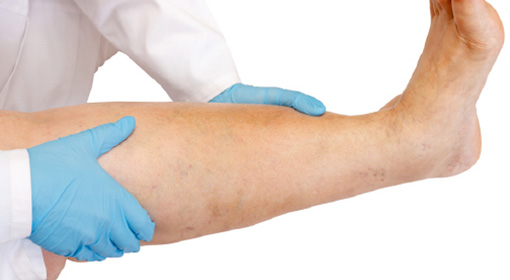
CVI is a progressive medical condition in which venous valves that help carry blood from the legs to the heart no longer function, causing blood to pool in the legs and veins to swell.  Healthy leg veins are designed to allow blood to flow against gravity from the legs back toward the heart.  Tiny valves inside the veins open and close to help control the flow and pressure.  CVI occurs when stresses on the venous system like the increased pressure of pregnancy, age, or standing for prolonged periods of time weaken and stretch the vein structure.  When the veins become weakened or diseased, the blood flow is impaired and the blood tends to pool in the legs.  This impaired blood flow or reflux causes veins to expand, change form and protrude from beneath the skin.
Unlike varicose veins alone where patients experience leg tiredness, heaviness or fatigue, additional changes in venous insufficiency include progressive symptoms that can be debilitating and significantly impact quality of life.  People who suffer from CVI may additionally experience:
Risk factors for the development of CVI include being overweight, having a sedentary life style, occupations that require prolonged sitting or standing, a history of deep vein thrombosis (DVT), the presence of spider or varicose veins with their corresponding risk factors.
CVI is a progressive medical condition in which venous valves that help carry blood from the legs to the heart no longer function, causing blood to pool in the legs and veins to swell.  Healthy leg veins are designed to allow blood to flow against gravity from the legs back toward the heart.  Tiny valves inside the veins open and close to help control the flow and pressure.  CVI occurs when stresses on the venous system like the increased pressure of pregnancy, age, or standing for prolonged periods of time weaken and stretch the vein structure.  When the veins become weakened or diseased, the blood flow is impaired and the blood tends to pool in the legs.  This impaired blood flow or reflux causes veins to expand, change form and protrude from beneath the skin.
Unlike varicose veins alone where patients experience leg tiredness, heaviness or fatigue, additional changes in venous insufficiency include progressive symptoms that can be debilitating and significantly impact quality of life.  People who suffer from CVI may additionally experience:
Risk factors for the development of CVI include being overweight, having a sedentary life style, occupations that require prolonged sitting or standing, a history of deep vein thrombosis (DVT), the presence of spider or varicose veins with their corresponding risk factors.
Spider veins, like varicose veins, are caused by dysfunctional vein valves.
View DetailsHealthy leg veins contain valves that allow blood to move in one direction from the lower limb toward the heart.
View DetailsVaricose veins are enlarged veins that can be blue, red or flesh colored.
View DetailsDeep vein thrombosis (DVT) is a blood clot that forms in a vein deep in the body.
View Details